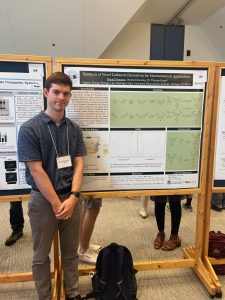Synthesis of novel carbazole derivatives for electrochemical applications
Daniel Swanson, Dennis Downing, and Thomas Guarr
Carbazoles are of particular interest for electrochemical applications such as redox-flow batteries (RFBs) because of their ability to undergo reversible electrochemical oxidation at high potentials. Polymerization of the carbazole radical cation decreases reversibility but can be subdued by blocking areas of high electron-spin density (1-,3-,6-, and 8-positions). Functionalization with electron-withdrawing groups has been shown to cause an increase in oxidation potential. Moreover, the addition of alkyl groups distorts the preferred planar geometry of the radical cation. Using an intramolecular oxidative coupling route previously discovered in our lab, we synthesized several carbazole derivatives bearing electron withdrawing groups at the 3- and 6-positions and methyl groups at the 1- and 8-positions. These carbazole derivatives were synthesized with the eventual goal of creating linked anolyte-catholyte materials for RFBs.
Daniel graduated with a Chemistry degree from Central Michigan University this spring, and joined us for the summer before he started at Michigan State University in East Lansing to study a Masters in Chemical Engineering. Daniel has a very bright future and he will be great at anything he wants to do. We appreciate that you spent the summer with us Daniel!



